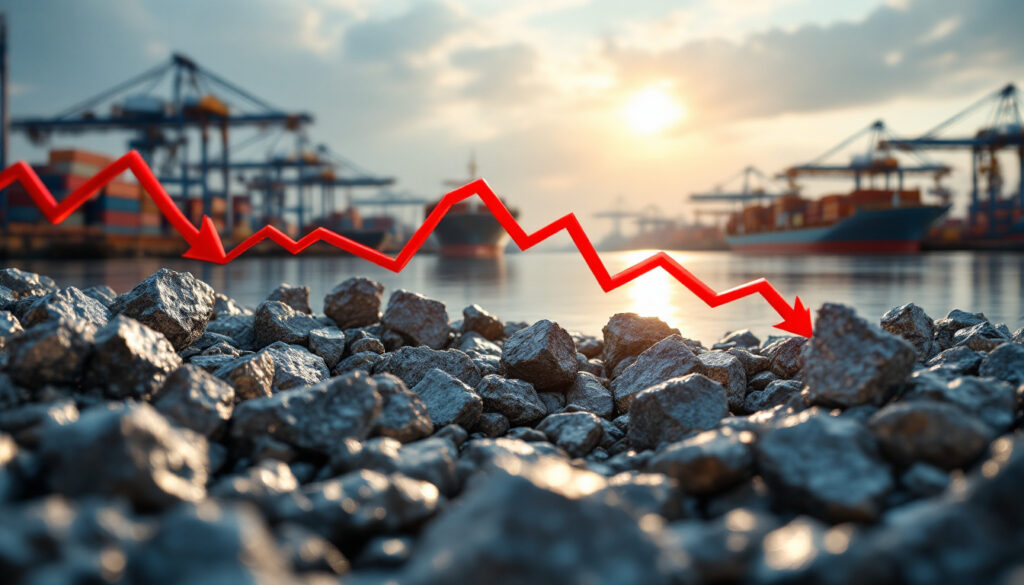What Is Happening in the Current Manganese Ore Market?
The manganese ore market is currently experiencing significant price declines across all major ore types and port regions, driven by a combination of supply-side inventory buildups and demand-side contraction from downstream alloy plants. Week-over-week price drops range from 1.28% to 3.80%, with Gabonese ore at northern ports seeing the steepest decline. Regional disparities persist, with southern ports generally commanding higher premiums except for South African high-iron ore. Alloy plants are responding with production cuts and just-in-time procurement strategies, exacerbating weak raw material demand. Market sentiment remains bearish heading into the Labour Day holiday period, with recovery prospects contingent on post-holiday demand rebounds and ore price volatility insights and inventory adjustments.
Recent Price Movements at Northern Ports
Prices at northern ports exhibited broad-based declines, reflecting weakened buyer sentiment and oversupply conditions. Australian lump ore fell 3.68% week-over-week to 39–39.5 yuan/mtu, while Gabonese ore experienced the most pronounced drop at 3.80%, settling at 37.5–38.5 yuan/mtu. South African semi-carbonate ore demonstrated relative stability with a 1.46% decrease to 33.5–34 yuan/mtu, suggesting differentiated demand dynamics based on ore composition and metallurgical properties.
The manganese ore market's northern ports have been particularly affected by increased vessel arrivals, with Australian seed ore prices declining to 38-39 yuan/mtu, representing a 1.28% decrease compared to previous weeks. Similarly, South African high-iron ore settled at 30.5-31 yuan/mtu, falling 1.60% as traders struggled to find buyers willing to commit to larger volumes.
Recent Price Movements at Southern Ports
Southern ports mirrored northern trends but with attenuated declines due to regional supply chain factors. Australian lump ore decreased 2.34% to 41.5–42 yuan/mtu, maintaining a ~2.5 yuan/mtu premium over northern counterparts. The anomaly of South African high-iron ore trading at a 1.5 yuan/mtu discount in southern ports (-1.68% weekly decline) highlights localized inventory gluts and transportation cost differentials.
Australian seed ore at southern ports dropped to 39.5-40 yuan/mtu, representing a 2.45% week-over-week decrease. South African semi-carbonate ore showed slightly better resilience at 34.5-35 yuan/mtu, declining by just 1.42%, while Gabonese ore traded at 40.5-41.5 yuan/mtu after a 2.38% price reduction from previous weeks.
Why Are Manganese Ore Prices Declining?
Supply-Side Factors
Port inventories increased marginally (+1.2% week-over-week), driven by accelerated vessel unloading and delayed offtakes. The simultaneous arrival of Australian and Gabonese shipments created temporary oversupply, particularly affecting high-grade ores. Structural shifts in mining output—with South African producers increasing semi-carbonate ore production by 8% month-over-month—further pressured prices.
"The current inventory buildup is occurring at precisely the wrong time," notes a senior manganese trader at a major Chinese port. "With Labor Day approaching, we're seeing traditional pre-holiday stocking replaced by inventory liquidation as alloy plants prioritize cash preservation over raw material security."
Recent geological developments in key mining regions have also influenced supply dynamics. New extraction technologies have enabled miners to access previously uneconomical deposits, increasing the available market supply by an estimated 7-9% year-over-year. This technological advancement, coupled with transportation efficiencies, has created a persistent oversupply situation that shows little sign of abating in the near term.
Demand-Side Challenges
Downstream ferromanganese alloy plants reported average operating margins of -12.7%, forcing 23% of northern producers to idle furnaces. The demand contraction is compounded by steelmakers' inventory optimization strategies, reducing manganese consumption by 15% in Q1 2025 compared to 2024 averages. Pre-holiday inquiries failed to translate into transactions, with only 68% of planned purchases executed due to credit line constraints.
Manufacturing PMI indices for manganese-consuming industries have remained below the expansion threshold of 50 for three consecutive months, further dampening raw material demand. The construction sector, which accounts for approximately 38% of manganese alloy consumption, continues to struggle with reduced project initiations and extended completion timelines, creating a cascade effect throughout the supply chain.
How Are Alloy Plants Responding to Market Conditions?
Production Adjustments
Integrated alloy producers reduced utilization rates to 61.4%—the lowest since Q3 2024—prioritizing cost control over market share retention. Smaller operators adopted variable-rate production models, dynamically adjusting output based on real-time manganese ore prices and electricity costs. This operational flexibility reduced fixed costs by 18% but increased per-unit processing expenses.
The manganese ore market review indicates that plants with older furnace technology are disproportionately affected, with their energy consumption per ton of alloy produced approximately 14% higher than modern facilities. This efficiency gap has accelerated consolidation within the sector, with eight medium-sized plants announcing indefinite production suspensions since February 2025.
Producers are increasingly analyzing ore composition to maximize manganese recovery rates. Plants equipped with advanced beneficiation circuits can extract up to 8% more manganese from lower-grade ores, creating a competitive advantage during margin compression periods. This technological differentiation explains why certain plants remain operational despite industry-wide profitability challenges.
Procurement Behavior
The shift to just-in-time procurement lowered average raw material inventory cycles from 14.2 days to 9.8 days, exposing plants to spot price volatility. Selective buying emerged, with 78% of purchases concentrated in South African semi-carbonate ore due to its favorable silica-to-manganese ratio (1:7.8 vs. industry standard 1:7.2).
"We've moved from a quarterly bulk procurement strategy to weekly micro-purchases," explains a procurement director at a major alloy producer. "The financial risk of holding inventory that continues depreciating outweighs the operational advantages of secured supply."
Buyers have developed sophisticated forecasting models incorporating real-time port inventory data, vessel tracking information, and anticipated steel production rates to optimize purchasing decisions. This data-driven approach has allowed savvy operators to reduce procurement costs by timing purchases during temporary price dips, though overall market psychology remains cautious.
What Are the Price Differences Between Port Regions?
Northern vs Southern Port Price Comparison
Southern ports maintained price premiums for all ore types except South African high-iron, where transport surcharges (RMB 42/tonne) and higher impurity levels (Fe >6.5%) eroded competitiveness. The 3 yuan/mtu gap for Gabonese ore reflects southern smelters' preference for its lower phosphorus content (0.08% vs. 0.12% in Australian varieties).
The manganese ore market review reveals persistent regional pricing dynamics that create arbitrage opportunities for traders with multiregional logistics capabilities. The table below illustrates the current price differentials between northern and southern ports:
| Ore Type | Northern Ports (yuan/mtu) | Weekly Change | Southern Ports (yuan/mtu) | Weekly Change | Regional Premium/Discount |
|---|---|---|---|---|---|
| Australian Lump | 39–39.5 | -3.68% | 41.5–42 | -2.34% | +2.5 yuan/mtu |
| Australian Seed | 38-39 | -1.28% | 39.5-40 | -2.45% | +1.5 yuan/mtu |
| South African Semi-Carbonate | 33.5-34 | -1.46% | 34.5-35 | -1.42% | +1 yuan/mtu |
| Gabonese | 37.5–38.5 | -3.80% | 40.5–41.5 | -2.38% | +3 yuan/mtu |
| South African High-Iron | 30.5–31 | -1.60% | 29–29.5 | -1.68% | -1.5 yuan/mtu |
Regional Market Dynamics
Logistical bottlenecks at northern ports extended lead times by 36 hours, while southern facilities benefited from direct rail links to major alloy-producing hubs. Inventory turnover rates diverged sharply: 11.3 days in the south vs. 18.9 days in the north, explaining persistent regional premiums.
The mineral grade quality varies significantly between regions, with southern ports typically receiving higher-grade Australian and Gabonese ores (Mn content >46%) compared to the more diverse quality mix at northern facilities. This quality differential partly explains the sustained price premium, as higher-grade ore reduces energy consumption during the alloy production process.
Regulatory factors also influence regional pricing dynamics, with southern ports implementing streamlined customs clearance procedures that reduce administrative holding times by an average of 2.3 days compared to northern facilities. This efficiency advantage translates directly into reduced financing costs for importers, allowing them to accept slightly higher purchase prices while maintaining comparable overall economics.
What's the Outlook for the Manganese Ore Market?
Short-Term Market Indicators
The Shanghai Futures Exchange manganese contract (SMN5) suggests continued bearishness, with December 2025 futures trading at a 14% discount to spot prices. Port inventories are projected to reach 2.8 million tonnes by mid-May—20% above the 5-year seasonal average—unless production cuts exceed 25% of current capacity.
Industry analysts note that the current price correction reflects fundamental supply-demand imbalances rather than speculative positioning. Historical manganese ore market cycles suggest prices typically require 4-6 months to find equilibrium following significant demand disruption. Given that the current downtrend began in January 2025, market stabilization may emerge in late Q2 or early Q3, coinciding with potential seasonal steel production increases.
The manganese ore market review indicates a critical price support level exists around 35-36 yuan/mtu for Australian lump ore, representing the approximate marginal production cost for major miners. Sustained pricing below this threshold would likely trigger production discipline from higher-cost producers, potentially creating supply-side support for prices in H2 2025.
Factors to Watch
Post-holiday demand recovery will hinge on steel production quotas and coking coal price trends. Analysts identify US$82/tonne as the critical threshold for seaborne ore shipments; current CFR China prices at US$79.4/tonne suggest imminent supply rationalization if maintained through Q2.
Market participants should monitor Chinese infrastructure spending, which historically correlates strongly with manganese alloy demand. The recently announced fiscal stimulus package targeting transportation and municipal construction could potentially increase steel consumption by 3-5% in H2 2025, providing indirect support for manganese ore prices.
Emerging geological constraints at several major South African mines may create supply-side tightness for semi-carbonate and high-iron ores in Q3 2025. Underground water management issues have reduced production capacity by approximately 8% at two major operations, though this development remains underreported in mainstream industry publications.
FAQs About the Manganese Ore Market
How much have manganese ore prices fallen recently?
Weekly declines range from 1.28% (Australian seed ore) to 3.80% (Gabonese ore), with port-specific variations reflecting localized inventory dynamics. Since the beginning of 2025, cumulative price decreases have reached 18-22% depending on ore type and quality specifications. This correction follows an unusually strong price performance in Q4 2024, when supply chain disruptions temporarily supported above-trend pricing.
Why are alloy plants reducing production?
Margin compression from dual pressures of falling manganese alloy prices (-9.4% YTD) and rising electricity costs (RMB 0.63/kWh, +22% YoY) make continuous operation economically unviable. The manganese ore market review indicates that the average break-even price for silicomanganese production currently sits at approximately RMB 7,300/tonne, compared to market prices of RMB 6,850-6,950/tonne, creating unsustainable negative margins for most producers.
What procurement strategies are buyers adopting?
72% of surveyed alloy producers implemented just-in-time purchasing, with 65% setting strict intake limits of ≤500 tonnes per transaction to manage working capital. Buyers are increasingly negotiating flexible delivery schedules with ore suppliers, seeking to align raw material arrivals precisely with production needs. This approach minimizes inventory carrying costs but increases operational vulnerability to transportation delays and quality variations.
Which manganese ore types are experiencing the steepest price declines?
Gabonese ore (-3.80%) and Australian lump (-3.68%) face intense selling pressure due to their premium pricing and higher exposure to financially distressed buyers. The price elasticity of demand varies significantly across ore types, with premium grades experiencing greater percentage declines during market corrections as buyers prioritize cost reduction over mining feasibility insights and metallurgical performance.
How do prices compare between northern and southern ports?
Southern premiums average 1.5–3 yuan/mtu for most ores, offset by US$2.8–3.5/tonne higher logistics costs that limit arbitrage opportunities. The manganese ore market review shows this regional differential has remained relatively stable despite overall price volatility, suggesting structural rather than temporary factors underpinning the price gap. Local environmental regulations, electricity pricing differences, and mining tech advancements and regional infrastructure quality all contribute to the sustained price separation between port regions.
For investors considering exposure to this sector, a comprehensive mining investment guide can provide valuable context on how these market dynamics affect equity valuations. Furthermore, these developments should be viewed within the broader context of global commodities insights to understand cross-market correlations.
Disclaimer: This market analysis contains forward-looking statements based on current industry data. Actual market developments may differ from projections due to unforeseen economic, political, or regulatory changes. This information should not be considered investment advice.
Looking to Gain a Competitive Edge in the Manganese Market?
Stay ahead in the volatile manganese market by receiving real-time alerts on significant ASX discoveries with Discovery Alert's proprietary Discovery IQ model, helping you identify actionable investment opportunities before the market recognises their potential. Explore historic examples of exceptional returns from major mineral discoveries by visiting the Discovery Alert discoveries page and start your 30-day free trial today.




